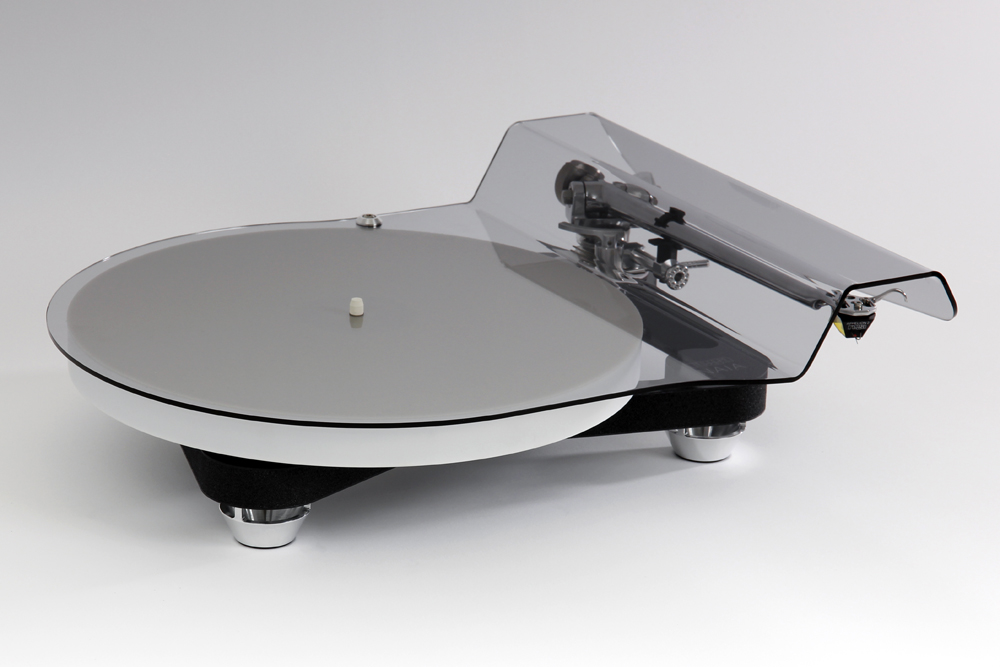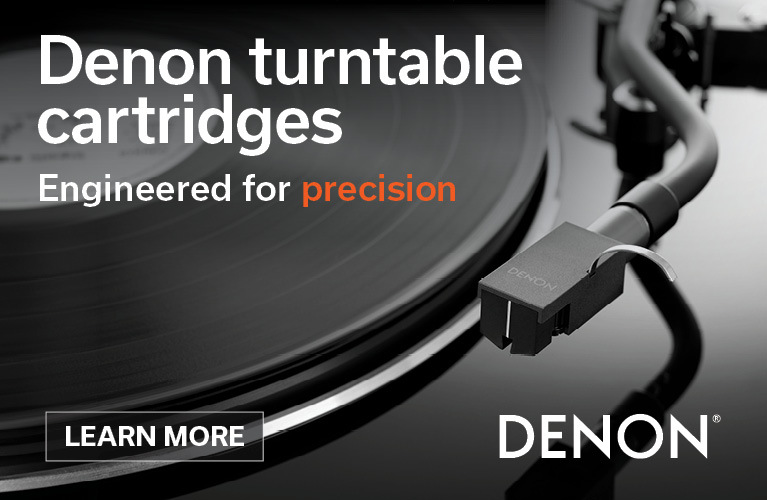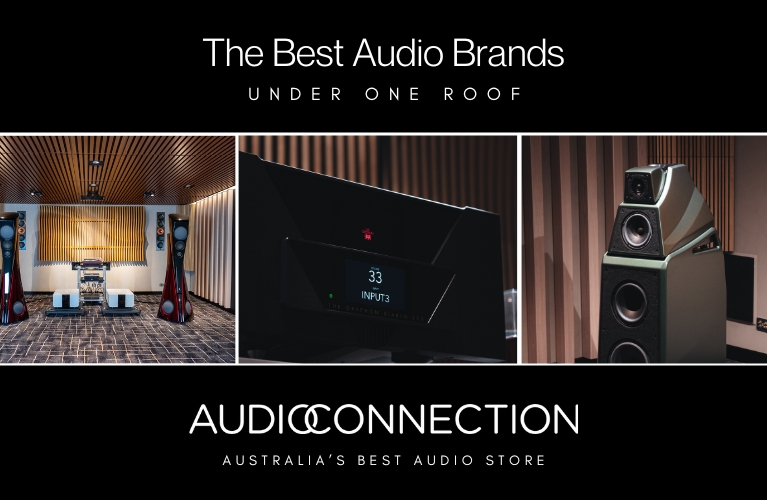Having started out my hi-fi journey in the early 1980s with a Rega Planar 3 turntable, I jumped at the chance to hear and review the latest flagship model from Rega. Called the Naia, this turntable offers all the accumulated technical knowledge gained during the existence of Rega Research’s 51 years of knowledge. The Naia package in this review includes the option for a factory fitted Aphelion 2, Rega’s top of the line moving coil cartridge.
In The Flowing River
The Rega Naia is an ultra-rigid lightweight design using a carbon fibre and foam sandwich construction for the plinth and a ceramic platter. The top-of-the-line RB Titanium Reference tonearm incorporates titanium metal in the bearing assembly said to reduce the overall weight and add stiffness to the arm.
Rega Research was formed in 1973 by engineer Roy Gandy a self-confessed lover of music. Roy made his own guitar from necessity and built his motorcycle from discarded parts. As a young man Roy owned several turntables from different manufacturers and decided he could build a better turntable which could be focused on giving the listener a more immersive musical experience.
 The original Rega Research Planet Turntable from 1973.
The original Rega Research Planet Turntable from 1973.
The very first Rega turntable was called The Planet and was introduced to the public in 1975. In 1977, the Planar 3 was introduced and sold so well that Rega Research (also referred to as just Rega) became known to the world’s Hi-Fi community. During the development of the Planar models Roy Gandy focused on producing turntables that used stiff, lightweight plinth materials that prevented energy absorption and unwanted resonances which could add unwanted distortions from impacting the music. Describing turntables as vibration reading machines, Roy Gandy has concentrated on the reduction of external vibration and the control of ‘vibration reading’ using lightweight designs and materials.
Rega now offers various turntable models, tonearms cartridges, cables, phono stages, digital-to-analogue converters, amplifiers, speakers, and CD players.
The Rega Naia turntable incorporates technology first used in a very limited design called the Naiad. Only 30 of the Naiad have been made so far out of a possible run of 50. Such was the enthusiastic response from the public and reviewers for the Naiad that Rega felt it was worth releasing a new model using the best of that technology but would not be limited in production. The Naia turntable was the result and was released in 2023.
In keeping with Rega design philosophy of lightweight plinths, the Naia uses a skeletal style plinth to keep weight to a minimum. The plinth uses Graphene impregnated carbon fibre “skins” to the top and bottom of a sandwich with a ‘Tancast 8’ foam centre. Graphene is a material made up of extremely thin – one atom thick! – carbon sheets which when added to carbon fibre greatly increases the strength and stiffness. The Tancast 8 foam was chosen for its lightness, high damping and easy machining properties. This foam is also used extensively in the aerospace industry.

Twin braces of flat ceramic aluminium oxide material is added to the top and bottom of the plinth which run from the platter bearing assembly to the tonearm mounting point to add rigidity and prevent bending and twisting forces from being generated while operating the motor.
The platter bearing is made from ZTA zirconium toughened alumina ceramic composite which has properties of high wear resistance, high rigidity and low weight. Ideal for a turntable bearing. A weight reduced aluminium sub platter forms part of the bearing assembly with the ZTA material forming the record spindle. Three short belts attach to the motor to provide drive to the platter. The belts are made from a special rubber compound developed by chemists in conjunction with Rega. The belts are then accurately machined to produce perfectly round and accurate dimensions. This is critical for speed stability of the platter, especially when using three belts.
The motor is a 24-volt AC low noise design which receives its power from the dedicated Power Supply Unit. The reference PSU provides stable AC voltage to the motor and speed control is changed via the two buttons, 33 and 45. No lifting the platter to change the speed on the Naia. Speed adjustment, if required, is accessed via the rear panel by pressing the Speed Program Switch. An LED flashes when in adjustment mode, speed is then set in 0.01 rpm steps via the Speed Adjustment button. A Cannon/XLR type connector from the turntable motor connects the PSU to the Naia. The elegant and Bauhaus inspired PSU comes in a smallish black anodised box, width being 218 mm by 80 mm height and 320 mm length.

Resting on top of the aluminium sub platter is the main platter which is made from the same ZTA ceramic material as the platter bearing. And what a beautifully formed piece of engineering it is. I deliberately placed the platter upside down to photograph the elegantly machined underside (see below). The Naia platter starts at the edge with a thickness of approx. 20mm and gently curves down to around 5mm at the centre. This is to reduce weight overall while adding mass to the outside for increased flywheel effect.
A soft felt platter mat sits on top of the ceramic platter to cushion and control unwanted vibration from effecting the record during playing.

The Rega Naia uses the hand-built flagship RB Titanium tonearm based on the RB 300 which was first produced in 1983. The RB Titanium uses a highly polished one-piece cast aluminium arm unit complete with an integrated head shell. Titanium is used in the vertical and horizontal bearing assemblies and is chosen for its high strength-to-weight, stiffness and dimensional stability. Rega uses its highest graded bearings closely fitted on the titanium vertical and horizontal spindles. This ensures very low friction for the arm travel and increases the amount of detail able to be extracted from the record. No measurable free play is found in the bearings and Rega have spent 30 years refining the design to enable the cartridge-tonearm combination to accurately read the smallest details in the record groove. Some of these micro details are as small as 10 microns or 0.01 mm. So, if a tonearm had 10 microns of bearing free play, then this musical information could be lost.
A high-density tungsten metal shaft and balance weight are fitted to the rear of the aluminium arm piece for vertical tracking force setting. The tonearm’s vertical bearing assembly sits inside Rega’s 3-point aluminium arm base which is bolted through the plinth sandwich construction. Rega’s level of engineering detail extends to the underside of the aluminium arm base where a large part of the mass is drilled out to reduce weight and to impart strength due to the shape of the circular drillings, as commonly found in aerospace and high-performance cars.
The RB Titanium tonearm uses a dynamic spring tracking force system to set the correct cartridge down force, which is adjusted via the tracking force dial located next to the horizontal titanium bearing assembly.

With the cartridge fitted and the anti-skate force set to zero, the tungsten weight is positioned so that the tonearm ‘floats’ in the horizontal position. The tracking force dial is turned clockwise to increase the force and corresponding numbers 0 and 3 are marked on the dial to indicate the weight in grams. Using a digital cartridge scale showed the dial indicators to be accurate (see below).
With tracking force done the arm can then be set for correct anti-skate force. This is adjusted by a very simple and elegant aluminium piston, or bias adjustment slider as Rega calls it. Pulling the slider all the way out reduces the anti-skate to zero, pushing in to the first of two milled lines takes the force to 1.0 gram and the second line to 2.0 grams.

At the head shell, Rega’s proprietary 3-point cartridge fixing is available to use on all Rega made cartridges. This ensures that the Rega cartridge has the correct overhang. Other manufacturers’ cartridges are catered for with twin adjustable slots for correct overhang and alignment.
The hand assembled tonearm wires are constructed using a low capacitance oxygen-free copper wire with external wires fitted into an ultra-flexible jacket. High quality Neutrik RCA plugs ensure perfect signal transfer and are shaped to ensure relief from mechanical strain which prevents any accidental damage to the RCA plugs.
The Naia skeletal plinth sits on three non-adjustable aluminium feet with thin rubber pads at the bottom. The skeletal form construction is designed for vibration control, so as to prevent external vibration from effecting the cartridge reading the record grooves.
Completing the Naia package is a simple but effective acrylic dust cover shaped to cover the platter and flows up and over the tonearm. The cover has a hole drilled in the centre to fit over the ceramic spindle while in order to lock into place and ensure stability, a ‘foot’ locates into a hole in the plinth aligned with the rear aluminium foot. Elegant and understated, the dust cover keeps the look of the design clean and functional.

The unpacking and assembly of the Rega Naia was straight forward and the instruction manual was concise and well laid out ensuring a smooth setup.
I was also sent Rega’s top of the line Reference MC phono stage the Aura MC which looks like a larger version of the black Naia PSU. Front controls include a very nicely done on/off switch incorporated on the front left hand side of the case work, a button for mono operation, mute switch, and a rotary dial to change MC input loading in steps of 50, 100, 150, 300, and 400 ohms. A second rotary dial changes capacitance loading in Pico-farad steps of 1000, 2000, 3200, 4300 and 5700. The Aura MC rear panel accepts IEC type power cables and RCA input and outputs. XLR outputs concludes the connections available.

The NAIA came fitted with Rega’s top of the line Moving Coil cartridge called the Aphelion 2. With an output of 0.35 mV, the Aphelion 2 is a medium output MC that has a fine line contact stylus mounted on a boron cantilever rod. Rega has developed its Moving Coils without the use of internal foam dampers or steel tie wires, the results of which Rega states add to tighter bass with super clear high frequencies. With a mass of 6 grams and medium compliance the Aphelion 2 should sound great in the Naia turntable package.
Deep River
Talking of sound, lets dive deep into the musical side of this flagship player. Now, I pointed out that Naia came factory fitted with the top of the line Aphelion 2 moving coil – this is not the same as having the cartridge aligned…
To set up for listening I levelled the Naia on the hi-fi stand and plugged into the Aura MC phono stage. The impedance was set to 100 ohms and capacitance at 1000 pF as per Rega recommendations. What I did discover with the Aura MC Phono stage was how quiet this unit is. I double checked that the connections where correct and yes they were, so the noise floor is very low and this will add to the dynamics and soundstaging ability of the Rega Naia turntable.
On first listening the stereo image was spread across the speakers but lacked precise details while having imprecise images. Musicality was a bit lacking, and the music sounded ‘heavy’. This was not what I was expecting so I brought out my test gear to investigate further. Firstly, the cartridge tracking force is recommended at 1.9 grams. Actual weight was 2.12 grams.
Looking next at channel separation. When adjusted correctly, this gives the sound stereo separation and places instruments in their correct positions (I am simplifying this a little, as other forces such as VTF and anti-skate are also involved).
Looking at the azimuth of the cartridge I found the left channel at -30.57dB and the right channel -20.27dB. Ideally these figures should be as close to each other as possible. The azimuth is important to set correctly in a cartridge, as this follows the same position that the original cutting lathe stylus took when making the lacquer used in making the stampers for vinyl reproduction.
Next thing I discovered was that the anti-skate was set to maximum, forcing the cartridge to extract more information from the right channel no doubt to compensate for louder music coming from the left channel due to the lower noise figure in the channel separation. Note how the dB figures have a minus in front of them so that as the numbers increase, they are getting quieter, and more signal/music is coming through… Still with me?
So, this requires adjustment of the bias plunger in order to restore channel balance. Reducing the anti-skate force to the appropriate lower setting and these are the great results that were achieved: -29.52dB for the left channel and -29.25dB for the right.

The Rega Aphelion 2 specifications show channel separation at equal to or greater than -29dB so the cartridge is now correct for azimuth and hopefully the musical results sing for themselves.
First up on the platter was a bit of fun “lounge music” from Martin Denny Forbidden Island released in 1958 on the London record label. This is very well recorded and can sound brilliant on the right gear. First track “Cobra” starts with a snake charmer wind instrument playing alongside xylophone, hand cymbals and tambourine. The instruments came across as natural sounding with lovely shimmering notes from the xylophone and realistic metallic flutters of the tambourine. The percussive instruments rang clearly, and the soundstage was wide and deep with the ability for the listener to pinpoint individual players on the stage at the Bora Bora Lounge in Hawaii.
The next track I played, “Port au Prince”, has a police whistle which sounded realistic and sharp, as a real whistle does. The congas had a lot of detail so that you could easily follow the rapid hand strikes while the xylophone shimmered its presence through the mix. “Exotica” starts off slow with some faux bird calls coming from the back of the stage, gentle conga strikes follow the xylophone melody through this slow piece of music which is very revealing here of the musicians’ position within the stage. This is a great recording for revealing sound images captured during the live performance and the Rega Naia showed this off extremely well. My intention was to just listen to a few tracks but the level of detail and soundstage imaging coming out of the grooves kept me wanting more, so I gave in and listened to the whole album.

Next up on the platter is Leonard Bernstein’s West Side Story this is a modern recording of this famous musical, released in 2021 on the Hollywood Records label. “Prologue” is an instrumental which cleverly portrays the two warring gangs stalking each other, getting into a fight and being chased off by a policeman. The instrumental comes across from the Naia with lots of swagger, and sharp dynamic swings in loudness and instrumentation. Congas sound true and the brass has a sweet fullness to it. The music builds in intensity before falling away, the violins sound natural with great tone. Finger clicking is realistic and so are the brief clangs of cow bells. The shrill police whistle comes through clearly and the whole instrumental has pace with great dynamic swings.
The Rega NAIA plays this record with gusto and musicality. Lots of detail, both micro and macro, all well highlighted across a wide and tall soundstage. Brilliant rendition. “Jet Song” features the male singers starting the song in Portuguese. It comes across clearly with great timbre to the voices with the various vocal differences laid bare and easy to follow. The vocals were clearly able to be positioned in the aural landscape showing the great stereo separation achieved by the Aphelion 2 Moving Coil and the brilliant tracking ability of the RB Titanium tonearm.

Now for some music with a little more bass. Onto the platter goes Leftfield’s iconic debut album from 1995 Leftism. First track “Release the Pressure” starts off slowly with a synth ‘bell like’ melody and falling series of notes before reggae singer Earl Sixteen comes into the house groove. Synth beats open to some deep bass and crashing synth chimes that push the song along with muscular dynamics. The Rega Naia has plenty of pace, rhythm, dynamics and oodles of bass. Shaking the floor at times Leftfield’s Leftism really shows how well the Naia can control and reduce airborne vibrations.
Naia is sited some three meters in front and outside of the left-hand speaker and is placed on a glass tabletop. Not a placement that is usually conducive to great sounds from a turntable! Yet the design and materials used in the Naia to isolate the record/cartridge interface from unwanted outside vibrations works brilliantly. The second track “Afro-Beat” from Leftism moves the BPM up several notches and again highlights Naia’s control with concise and clear drumming. A turntable to sound good must impart good timing and be able to provide enough flywheel power to overcome stylus drag during complex musical passages. The Naia has no difficulty in allowing the music to flow effortlessly with oodles of detail and dynamic muscularity.
Now turning to piano jazz great Duke Ellington’s Piano in the Foreground recorded in 1961. This copy is a repressing from 2012 on WaxTime Records using the Direct Metal Mastering DMM system. I find DMM recordings have great clarity and wonderful dynamics if the mastering is done well, and it most certainly is here. On the track “Cong-Go” my listening notes refer to contrast between Duke Ellington’s sublime piano playing and Sam Woodyard’s subtle drumming.

The lack of background noise from the partnership of the Rega Naia and the Aura phono stage allows deep listening to the sweet and, at time, liquid midrange emanating from the speakers. My speaker’s tweeter and midrange drivers are made using beryllium and are known to shriek and sound metallic in a bad way when the playing medium is poor, but that is not the case here. Only beautifully rendered music projetcs from the speakers – accurate, dynamic and fun! The piano notes are clean and sharp when struck hard and have a natural decay fading into the quiet background. An impressive recording from 1961.
Conclusion
So Rega has brilliantly fulfilled its quest for a flagship turntable that uses advanced materials, knowledge and designs that have been studied and refined for the last fifty-odd years. Rega has proved that it can build a comprehensive turntable package in the Naia and its accompanying RB Titanium tonearm and APHELION 2 Moving Coil cartridge.
The clever combination of lightweight and advanced materials allows Naia to produce a highly musical experience. The Rega Research Naia turntable wows the listener with its insight, control and immersive musical portrayal.
… Mark Busby
www.soundstageaustralia.com
Associated Equipment
- Speakers – Yamaha NS-1000M, custom 18-inch subwoofer
- Preamplifier – PS Audio BHK, Music First Audio step up transformer, EMIA two-box tube phono stage
- Amplifier – Yamaha B1, Musical Fidelity Tri-Vista 300, Leak Stereo 60, restored Leak Stereo 20
- Sources – Analogue: Technics SP10 mk3 turntable with Stax UA7 Tonearm, Garrard 410 and SME V arm, Thorens TD 124 Mk1 with Woodsong bearing, SME 3012 silver wired tonearm, Music Maker 3 moving iron & DS Audio DS-003 optical cartridges, Tube Sound Audio phono stage, Sansui TU-717 tuner. Digital: Marantz CD-12/DAC-12
- Cables – Vertere Pulse-C, Revelation Audio Labs
Rega Research Naia Turntable
Price: AU$19,999 (AU$24,999 with Aphelion 2 MC cartridge)
Australian Warranty: Three Years (90 Days for Cartridge and Styli)
Australian Distributor: Synergy Audio
+61 3 9459 7474
www.synergyaudio.com
Rega Research
Unit 6 Coopers Way, Temple Farm Industrial Estate
Southend-On-Sea, Essex SS2 5TE
United Kingdom,
+44 1702 333 071
www.rega.co.uk












